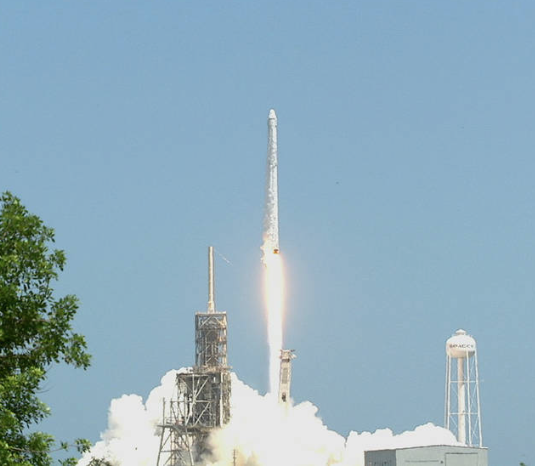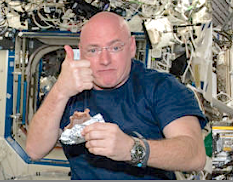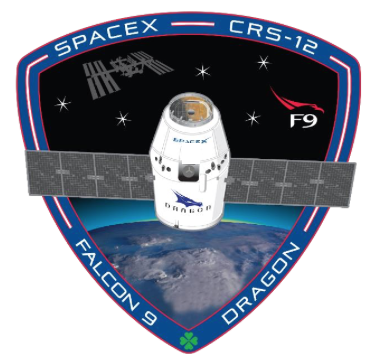

SpaceX launched its 12th resupply mission to the International Space Station from NASA's Kennedy Space Center in Florida at 12:31 p.m. EDT on Monday, August 14, 2017. Credits: NASA Television
Those goodies that the astronauts are awaiting will arrive thanks to another successful SpaceX launch on Monday, August 14. Resupply missions to the International Space Station are celebrated making the bridge to the astronauts when they crave a favorite snack or have the need of a basic necessity, but they can't just hop in their car and go to the store, that's when SpaceX delivers.

Thumbs-up for a favorite snack!
On August 14, 2017, SpaceX successfully launched its twelfth Commercial Resupply Services mission (CRS-12) from Launch Complex 39A (LC-39A) at NASA’s Kennedy Space Center, Florida. Liftoff occurred at 12:31 p.m. EDT, or 16:31 UTC and was followed approximately two and a half minutes later by successful separation of the first and second stages. The first stage of Falcon 9 then successfully landed back at SpaceX’s Landing Zone 1 (LZ-1) at Cape Canaveral Air Force Station, Florida.
SpaceX and NASA SpaceX CRS-12 makes it an even dozen as it is the twelfth of up to 20 missions to the International Space Station that SpaceX will fly for NASA under the first CRS contract. In January 2016, NASA announced that SpaceX’s Falcon 9 launch vehicle and Dragon spacecraft were selected to resupply the space station through 2024 as part of a second Commercial Resupply Services contract award.
Then on August 16, International Space Station astronauts Jack Fischer of NASA and Paolo Nespoli of ESA (European Space Agency) will use the station’s 57.7-foot (17.6-meter) robotic arm to reach out and capture the Dragon spacecraft and attach it to the station. The Dragon spacecraft is filled with over 6,400 pounds of supplies and payloads, including critical materials to directly support dozens of the more than 250 science and research investigations that will occur during Expeditions 52 and 53.
Experiments that will be conducted include:
- Research materials flying inside the Dragon's pressurized area include an experiment to grow large crystals of leucine-rich repeat kinase 2 (LRRK2), a protein believed to be the greatest genetic contributor to Parkinson’s disease. Gravity keeps Earth-grown versions of this protein too small and too compact to study. This experiment, developed by the Michael J. Fox Foundation, Anatrace and Com-Pac International, will exploit the benefits of microgravity to grow larger, more perfectly-shaped LRRK2 crystals for analysis on Earth. Results from this study could help scientists better understand Parkinson’s and aid in the development of therapies.
- The Kestrel Eye (NanoRacks-KE IIM) investigation is a microsatellite carrying an optical imaging payload, including a commercially available telescope. This investigation, sponsored by the U.S. National Laboratory, tests the concept of using microsatellites in low-Earth orbit to support critical operations, such as lowering the cost of Earth imagery in time-sensitive situations such as tracking severe weather and detecting natural disasters.
- The Cosmic Ray Energetics and Mass instrument will be attached to the Japanese Experiment Module Exposed Facility on the space station, and measure the charges of cosmic rays. The data collected from its three-year mission will address fundamental questions about the origins and histories of cosmic rays, building a stronger understanding of the basic structure of the universe.

The Dragon is scheduled to depart the space station in mid-September, returning with more than 3,300 pounds of science, hardware and crew supplies to Earth. About five hours after Dragon leaves the space station, it will conduct its deorbit burn, which lasts up to 10 minutes. It takes about 30 minutes for Dragon to reenter the Earth’s atmosphere and splash down in the Pacific Ocean off the coast of Baja California.
For more than 16 years, humans have lived and worked continuously aboard the International Space Station, advancing scientific knowledge and demonstrating new technologies, making research breakthroughs not possible on Earth to enable long-duration human and robotic exploration into deep space. A global endeavor, more than 200 people from 18 countries have visited the unique microgravity laboratory that has hosted more than 1,900 research investigations from researchers in more than 95 countries.
For more information about the mission and payloads, visit.

